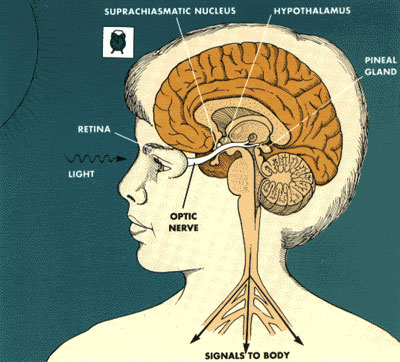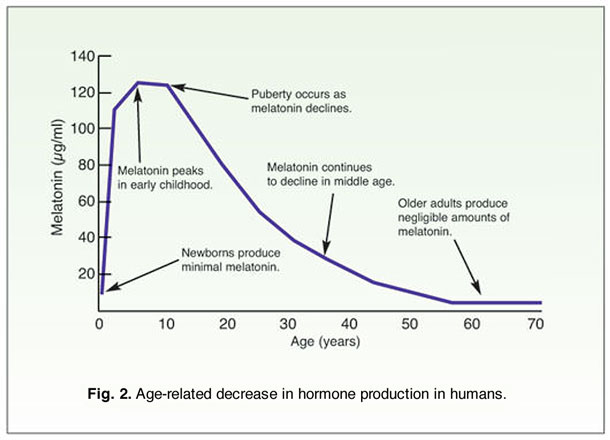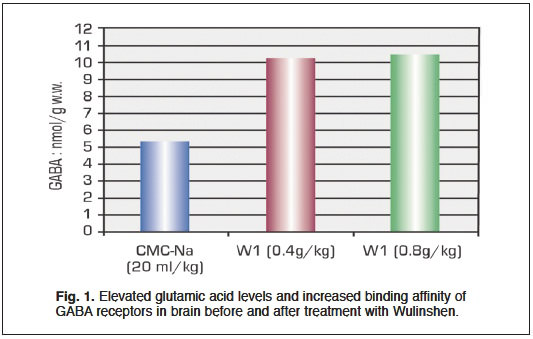 If you have trouble falling asleep, wake up frequently in the middle of the night, or drag yourself out of bed in the morning feeling drained and exhausted, you’re not alone. A survey conducted by the National Institute of Neurological Disorders and Stroke reveals that as many as 40 million Americans suffer from disrupted and inadequate sleep.(1)
If you have trouble falling asleep, wake up frequently in the middle of the night, or drag yourself out of bed in the morning feeling drained and exhausted, you’re not alone. A survey conducted by the National Institute of Neurological Disorders and Stroke reveals that as many as 40 million Americans suffer from disrupted and inadequate sleep.(1)
Impaired sleep exerts a heavy toll on physical and emotional health. In addition to increasing stress, irritability, depression and daytime drowsiness, lack of sleep also affects concentration, alertness, and reflexes, making sleep-deprived individuals more prone to falls and accident-induced injury.(2)
Sleep loss has also been linked to a number of serious health conditions, including obesity, heart disease and Type 2 diabetes. Significantly, new research suggests that inadequate and/or fragmented sleep may be linked to premature death in older adults.
Sales of over-the-counter and prescription sleeping aids continue to rise, driven by increasing numbers of restless insomniacs seeking help for lifestyle-related sleep disorders. Modern pharmaceuticals are widely prescribed for relief from insomnia, sleep apnea and restless leg syndrome, while natural supplements such as melatonin and 5-HTP are commonly used to relieve jet lag and to help shift workers (police officers, nurses, etc.) who struggle with constantly changing sleep schedules.
To Sleep, Perchance to Dream…
Humans need little beyond food, water, air and sleep to survive. Of these, sleep remains the most mysterious and elusive requirement. While researchers do not yet fully understand the nature of sleep, what has been established is that regular bodily rest is absolutely critical to physical and mental health.
Human sleep is controlled by an internal biological “body clock” that is synchronized to a normal, 24-hour day/night circadian cycle (circadian is Latin for “around a day”). Circadian cycles control a wide range of physiological and behavioral processes, including brain wave activity, alertness, body temperature, hormone production and cell regeneration.
 In humans and other mammals, circadian sleep cycles are controlled by a small organ called the suprachiasmatic nucleus (SCN). Located in the hypothalamus at base of the brain (Fig. 1), the SCN synchronizes internal circadian rhythms with changing light levels from the external world (i.e., sunrise, sunset). When light levels are elevated, receptors in the eye stimulate the SCN to inhibit the release of the master sleep hormone, melatonin, from the pineal gland. As light levels drop with the approach of night, impulses from the SCN cease, allowing melatonin to be released to initiate sleep.
In humans and other mammals, circadian sleep cycles are controlled by a small organ called the suprachiasmatic nucleus (SCN). Located in the hypothalamus at base of the brain (Fig. 1), the SCN synchronizes internal circadian rhythms with changing light levels from the external world (i.e., sunrise, sunset). When light levels are elevated, receptors in the eye stimulate the SCN to inhibit the release of the master sleep hormone, melatonin, from the pineal gland. As light levels drop with the approach of night, impulses from the SCN cease, allowing melatonin to be released to initiate sleep.
When it works correctly, the SCN maintains precise control over sleep patterns, constantly monitoring light cues and sending out signals to either keep us alert or trigger the onset of sleep. Unfortunately, this mechanism is sensitive to disruption and its timing can be thrown off, resulting in disruption of sleep cycles. A prime example of this is jet lag, which occurs when external light cues are altered after crossing multiple time zones.
Symptoms of jet lag – fatigue, sleep disruption, confusion, anxiety, depression and constipation – are also experienced by older adults with disturbed sleep patterns. Researchers now believe that age-related disruption of human circadian sleep patterns is linked to alterations in the body’s normal timekeeping system.
Phases of Human Sleep
Human sleep occurs in two distinct phases: REM (Rapid Eye Movement) and non-REM sleep. Non-REM sleep initiates the beginning of each sleep cycle and consists of four stages:
- Stage 1 non-REM – Light Sleep: The drowsy transition between wakefulness and sleep is characterized by slowly rolling eye movements and the ability to awaken easily.
- Stage 2 non-REM – Decreased Awareness: Sensory awareness is reduced as the brain disengages from the external environment. Stage 2 is marked by slower brain waves, interspersed with rapid waves.
- Stage 3 & 4 non-REM – Slow Wave Sleep: The final stages of non-REM sleep, referred to as Slow Wave Sleep or Deep Sleep, are marked by low heart and respiratory rates, extremely slow brain waves and a complete lack of eye movement or muscle activity. Arousal from slow wave sleep is difficult and may result in disorientation and confusion. Slow Wave Sleep allows the body to direct its resources to regenerating tissues, building bones and muscle, recharging energy stores and strengthening the immune system.
REM Sleep
REM sleep is marked by periods of rapid eye movement and intense dreaming, possibly related to the process of “memory consolidation” wherein the brain sorts through the previous day’s experiences to store long-term memories. As the body cycles between non-REM and REM sleep throughout the night, each recurring REM cycle lasts longer than the previous ones, with the final REM phase lasting up to an hour.
Humans spend almost 50 percent of their total sleep in stage 2 non-REM sleep, about 20 percent in REM sleep, and the remaining 30 percent in the other stages. Infants, by contrast, spend about half of their total sleep time deep in REM sleep.
Age-Related Sleep Problems
One of the biggest problems facing adults is losing the inability to achieve a deep, restful sleep, and by age 64 about half of all adults report some form of sleeping disorder.(3) Age-related sleep disorders have been linked to biochemical changes in the body’s internal clock that alter the normal response to external light cues. This results in older people going to sleep earlier in the evening and waking up earlier in the morning. Older sleepers also tend to wake up more frequently during the night, resulting in fragmented sleep.
Sleep Loss Begins in Middle Age
In the first study of its kind, sleep researchers at the University of Pittsburgh have shown that altered sleep patterns actually begin in middle age. This finding surfaced as researchers tracked sleeping patterns of 110 healthy volunteers, aged 20 to 59 years. They found that both the quality and duration of sleep changed dramatically between the mid-20s and the mid-50s, with subjects going to bed and waking up earlier. The subjects also slept less, woke up more often during the night, and experienced fewer stages of deep sleep.(4)
According to study author, Dr. Julie Carrier, “Middle age is a turning point for sleep. Some sleep patterns have already changed significantly by the time an average adult reaches age 30.” Dr. Carrier observed that these changes are most likely tied to gradual age-related changes in features of the biological clock. “We need to learn where the system breaks down. If we are able to find out what is causing the biological clock to change with age, we may be able to discover ways to overcome these changes and help get these people back on track.”
Progressive Loss of Melatonin
As scientists continue to investigate the body’s biological clock, established research has already linked disrupted sleep patterns to age-related alterations in hormone production. One example is the age-related decline in melatonin, the principal sleep hormone produced by the pineal gland. Melatonin is involved in regulating the neuroendocrine system and controlling essential functions such as metabolism, sex drive, appetite, and sleep. Melatonin also exerts powerful antioxidant activity and plays a key role in the immune system by preventing the proliferation of cancer cells.
 Melatonin levels are known to drop significantly after childhood and serve as one of the most dramatic markers of biological aging known. By the age of 60, nighttime melatonin production practically ceases, and by age 80 melatonin plasma levels are barely detectable (Fig. 2).
Melatonin levels are known to drop significantly after childhood and serve as one of the most dramatic markers of biological aging known. By the age of 60, nighttime melatonin production practically ceases, and by age 80 melatonin plasma levels are barely detectable (Fig. 2).
Obesity Linked to Lack of Sleep
Sleep scientists have identified additional links between disrupted sleep cycles and age-related alterations in hormones involved in appetite control and obesity. In one study, researchers from the Stanford University School of Medicine have shown that getting less than 8 hours of sleep leads to increased levels of ghrelin, a hormone produced by the stomach that makes people hungry, slows metabolism and decreases the body’s ability to burn fat.(5) Ghrelin levels in the blood spike prior to meals and drop afterward. People receiving ghrelin injections become voraciously hungry, consuming up to 30 percent more calories than normal.(6)
The Stanford researcher team discovered that inadequate sleep also results in lower levels of another appetite hormone, leptin. In contrast to ghrelin, lower levels of leptin send out signals telling the body that it is starving, leading to increased appetite and driving the consumption of extra calories.
The Stanford study revealed a 14.9 percent increase in ghrelin levels, and 15.5 percent decrease in leptin levels in people who consistently slept for only five hours, compared with those who slept for eight. These findings are supported by previous studies that show that people who get less than four hours of sleep each night are 73 percent more likely to be obese than normal sleepers.
Loss of Slow Wave Sleep (SWS) Linked to Drop in Growth Hormone Production
Researchers from the University of Chicago School of Medicine have linked sleep loss with age-related drops in human growth hormone (GH). Growth hormone, which is normally released during the most restful phase of Slow Wave Sleep (SWS), plays a vital role in human health by stimulating bone growth, immune function, amino acid uptake, protein synthesis and muscle glucose uptake. Growth hormone also induces burning of fat from adipose tissues and plays a key role in maintaining cardiovascular health.
Reduction of growth hormone release in aging humans is associated with immune system malfunctions, increased body fat deposits, loss of muscle tone and overall physical strength, thinning of skin, and diminished sexual drive.
When the Chicago researchers monitored the sleep patterns of 149 healthy men, aged 16 to 83 years, over a period of 14 years they discovered that the total amount of time spent in slow wave sleep (SWS) dropped from 19% of total sleep in early adulthood to only 3% by midlife. This decline in restorative Slow Wave Sleep was matched by major declines in the secretion of human growth hormone.(7)
Elevated Cortisol and REM
In the same study the Chicago researchers noted a significant increase in evening levels of cortisol in subjects 50 years and older. Higher cortisol levels were associated with increased sleep fragmentation and further declines in REM sleep. Cortisol, the body’s principal anti-inflammatory hormone, is typically released by the adrenal glands in response to stress. While some cortisol is necessary for normal health, chronically elevated cortisol levels (hypercortisolemia) are known to contribute to obesity, hypertension, reduced glucose tolerance (a contributing factor in developing diabetes), loss of bone density, decreased muscle mass and increased neuronal death of brain cells.
Sleepless Rats Reveal Problem in Biological Clock
Two additional studies seem to confirm that problems within the body’s cellular clock are a crucial source of age-related sleep problems, while suggesting that this clock can be “reset” to more youthful levels – at least in aged rats.
In the first study, researchers at Washington University in St. Louis examined cells from the suprachiasmatic nucleus (SCN). They discovered that electrical activity of the “clock cells” in older rats was irregular, compared with the activity of timing cells in young and middle-aged animals. According to Erik Herzog, Ph.D., assistant professor of biology at Washington University, “In the case of the aged rats, many of them showed fragmented behavioral rhythms. The cells in the older rats were still rhythmic, but showed bouts of activity when they normally would have rested, and inactivity when the young animals were active. So, the rats, like elderly humans, took naps when they would have normally been active. Remarkably, the cells in their biological clock reflected this behavior.”(8)
Research Links Healthy Biological Clock to Longevity
In a related study supported by the National Institute on Aging in the US and the Natural Sciences and Engineering Research Council in Canada, researchers transplanted fresh brain cells harvested from the suprachiasmatic nucleus of young hamsters into the biological clocks of aging hamsters. Normally, once a hamster’s biological clock has begun to deteriorate, death occurs within three months. However, after the researchers transplanted the new “clock” cells into the older hamsters whose own clocks had begun to deteriorate, the animals lived an average of four months longer than hamsters without the transplant – equivalent to increasing lifespan by an astonishing 20 percent.
According to psychologist Martin Ralph of the University of Toronto, other therapies might achieve similar results. “If the function of the clock can be mimicked by a structured lifestyle, such as more light during the day and darkness at night, then this will work in the same direction as the transplant works in hamsters.”(9)
Poor Sleep Linked to Early Death in Older Adults
Sleep disturbances have been shown to double the risk of death for healthy older adults as compared to more restful seniors, according to new research. Lying awake for 30 minutes or longer and spending a smaller percentage of the night asleep boost the risk of death among older adults, according to Mary Amanda Dew, Ph.D., and colleagues at the University of Pittsburgh School of Medicine.
Older adults who sleep poorly tend to have a diminished quality of life, but the study by Dew and colleagues suggests that sleep disturbances can have a much more serious effect on health.
“Interventions that optimize or protect sleep initiation and sleep quality in old age might not only add quality of life but prolong life as well,” Dew says.
In eight different studies between 1981 and 1997, the researchers used EEG monitors to observe sleep patterns in 185 healthy adults 60 to 90 years old. Dew and colleagues then collected follow-up information to find which study participants had died by the year 2001.
The 66 adults who had died were more likely in the earlier sleep studies to lie awake for long periods, to sleep less “efficiently” through the night and to have abnormally high or low amounts of REM sleep, compared to study participants who were still living at the time of follow-up.
The link between poor sleep and earlier death remains significant, even after adjusting for the influence of age, gender and existing health problems, the researchers note.(10)
An Alternative Approach to Restoring Deeper, Healthier Sleep Cycles
Desperately tired people tend to seek solutions that can aid them in falling asleep quickly. Unfortunately, many over-the-counter and prescription sleep aids fill this need with a variety of products that act by knocking people out instead of addressing the issues underlying sleep disorders. A more rational, comprehensive approach to sleep health would be one that:
- Promotes a state of calm to initiating the natural process of gently falling asleep.
- Shortens the length of time it takes to fall into a restful slumber.
- Restores healthy sleep patterns and improves sleep overall quality over time.
- Gradually extends the duration of regenerative Slow Wave Sleep (SWS) periods.
- Allows users to wake up feeling refreshed, energized and restored.
 Unique Botanical
Unique Botanical
Xylaria Nigripes is a highly valued medicinal fungus traditionally used in Chinese medicine. Rich in carbohydrates and protein, Xylaria Nigripes boasts an impressive slate of essential amino acids, vitamins, minerals, trace elements, and glycoproteins that have been shown to offer a broad range of health benefits.
Human clinical studies have demonstrated that Xylaria Nigripes aids in regulating, supporting and promoting healthy human endocrine, immune, digestive, and metabolic functions.(11) Researchers have been most enthused with Xylaria Nigripes’ potential to aid in normalizing sleep, menstrual health, prostate function, mental sharpness, and cognitive function. Research has shown that Xylaria Nigripes supports several conditions, including:
- Overall wellness and well-being
- Anemia
- Cognitive function
- Menstrual function
- Mood
- Prostate function
- Improved sleep
As one might imagine, wild Xylaria Nigripes is very rare, difficult to find, and extremely expensive. Fortunately, researchers utilizing state-of-the-art pharmaceutical technology have developed a patented fermentation process that allows for the production of a pure proprietary Xylaria Nigripes extract, called Wulinshen, that is much more affordable.
Deep-Sleep Nutrients
Wulinshen contains a unique combination of ‘deep-sleep’ nutrients that research has shown capable of helping to ‘relax the brain’ and promote a sense of calm. As a result, Wulinshen is capable of safely restoring restful, recuperative sleep without the addictive or cloudy-headed effects often associated with prescription sleep remedies.
Wulinshen contains glutamic acid, gamma-aminobutyric acid (GABA) and glutamate decarboxylase, all of which are known to assist in the uptake of GABA by specific brain cell receptors that exert a mild tranquilizing effect on the central nervous system.
In pharmacological studies, elevated levels of glutamic acid and gamma-aminobutyric acid (GABA) have been shown to upregulate the binding affinity of GABA receptors in the brain in subjects in treatment groups (Fig. 1). Furthermore, the activity of glutamate decarboxylase (GAD) was also increased in these subjects, indicating that Wulinshen possesses the ability to enhance the entry of glutamic acid and GABA into the brain to activate GABA receptors, resulting in significant sedative, sleep-promoting and mood-elevating effects.

Peaceful Sleep
In addition to promoting a safe, mild sedative-like effect, Wulinshen has been shown to reduce the time needed to fall to sleep while prolonging the duration of sleep time. This effect was shown to be both mild and accumulative, and most evident following 7 to 8 days of use.
Boosting Learning Ability and Memory
In addition to an abundance of amino acids, vitamins, and various other nutrient substances, the rich glutamic acid content in Wulinshen aids in promoting metabolism, protein synthesis and transmission of stimulative signals in nerve synapses. This “heightened sense of synaptic awareness” is closely related to the phenomena of long-time synaptic potentialization (LTP) observed during learning. In addition to improving learning ability and memory, research with Wulinshen suggests that the compound also increases the permeability and intake of glutamic acid and GABA into brain tissue to support improved regulation of the central nervous system.
Phase II Clinical Study
In a Phase II clinical study carried out from November, 1997 through February, 1998 at a number of Chinese hospitals, researchers selected 467 individuals to be randomly assigned to one of three study groups. The study results demonstrated that participants in the Wulinshen-treated group experienced significantly better quality sleep than the participants in the control group. Additionally, treated subjects showed improvements in a number of sleep-related conditions, including insomnia, dementia, anxiety and chronic fatigue syndrome.
Long-Term Sleep Improvements
In addition to the improvements in sleep quality reported by the Wulinshen-treated participants, the Phase II Clinical study revealed that Wulinshen’s sleep-promoting effects may persist for two weeks, or longer, following supplementation. At the end of the study the researchers concluded that Wulinshen was effective for reducing the severity of insomnia among the participants and that Wulinshen was an effective sleep treatment for users of all ages and duration of insomnia.
Phase III Clinical Study
A Phase III clinical study of Wulinshen was conducted at 11 participating hospitals across China from October, 1998, through February, 1999. Since the Phase II studies had already shown that Wulinshen exerted statistically significant improvements in sleep, the purpose of the Phase III study was to further verify the general benefits of Wulinshen. Results from the Phase III clinical study mirrored the previous study, with 90 percent of the participants reporting sleep quality that was either improved, much more improved, or completely symptom-free. As in the Phase II trial, this study also documented Wulinshen’s extended, post-supplementation, sleep-promoting effect.
Summary
Wulinshen is a mild-acting botanical that has been shown to aid in correcting underlying imbalances that can negatively affect sleep patterns. Unlike harsher sleep options that exert a ‘sledge-hammer’ effect on mind and body, Wulinshen works by targeting each phase of human sleep to gently enhance the quality and duration of deep, restorative sleep to aid the body in recovering from daily physical and mental stresses. No drowsiness, foggy feeling or memory impairment has been reported or observed with Wulinshen.
References
1. NIH Office of Communications and Public Liaison, National Institute of Neurological Disorders and Stroke
2. http://www.sleepfoundation.org
3. E. J. W. Van Someren. “Circadian and sleep disturbances in the elderly.” Experimental Gerontology, Volume 35, Issues 9-10, December 2000, Pages 1229-1237.
4. University Of Pittsburgh Medical Center. “Deterioration Of Sleep During Middle Age Related To Changes In The Biological Clock.” ScienceDaily 25 June 1998.
5. Stanford University Medical Center. “Stanford Study Links Obesity To Hormonal Changes From Lack Of Sleep.” ScienceDaily 9 December 2004.
6. Plasma ghrelin levels after diet-induced weight loss or gastric bypass surgery. N Engl J Med. 2002 May 23;346(21):1623-30.
7. Age-Related Changes in Slow Wave Sleep and REM Sleep and Relationship With Growth Hormone and Cortisol Levels in Healthy Men Eve Van Cauter, PhD; Rachel Leproult, MS; Laurence Plat, MD JAMA. 2000;284:861-868.
8. Washington University In St. Louis (2001, August 14). Sleepless Aged Rats Show Biological Clock Problems. ScienceDaily.
9. University Of Toronto (1999, March 29). Research Links Healthy Biological Clock To Longevity. ScienceDaily.
10. Center For The Advancement Of Health, 2003, February 4.
11. Huey-Jiun Koa, Airong Songb, Min-Nan Laic, Lean-Teik Ngd. Immunomodulatory properties of Xylaria nigripes in peritoneal macrophage cells of Balb/c mice. J Ethnopharmacol. 2011 Dec 8;138(3):762-8. doi: 10.1016/j.jep.2011.10.022. Epub 2011 Oct 20.
12. Song A1, Ko HJ, Lai MN, Ng LT. Protective effects of Wu-Ling-Shen (Xylaria nigripes) on carbon tetrachloride-induced hepatotoxicity in mice. Immunopharmacol Immunotoxicol. 2011 Sep;33(3):454-60. doi: 10.3109/08923973.2010.534100. Epub 2010 Nov 26.
13. Zhao Z., Li Y., Chen H., Huang L., Zhao F., Yu Q., Xiang Z., Zhao Z.. Xylaria nigripes mitigates spatial memory impairment induced by rapid eye movement sleep deprivation. Int J Clin Exp Med. 2014 Feb 15;7(2):356-62. eCollection 2014.
14. Lin Y, Wang XY, Ye R, Hu WH, Sun SC, Jiao HJ, Song XH, Yuan ZZ, Zheng YY, Zheng GQ, He JC. Efficacy and safety of Wuling capsule, a single herbal formula, in Chinese subjects with insomnia: a multicenter, randomized, double-blind, placebo-controlled trial. J Ethnopharmacol. 2013 Jan 9;145(1):320-7. doi:10.1016/j.jep.2012.11.009.














[…] and disrupts neurotransmitter production. Convenient? You bet! Healthy? Not a chance! Click here to learn a bit more about this. And here is a nifty little compilation of research on blue light […]
[…] making it easier to fall asleep and allowing us to spend more time in slow-wave sleep. (That’s a deep stage of sleep that comes with some major benefits for mental and physical health, including sharper cognitive […]
[…] little melatonin production left, as there is an age-related decline of melatonin production. The melatonin production is highest in younger years and lowest in older […]
[…] 2. Increases in Slow Wave Sleep […]
[…] sleep involves REM sleep — where dreaming occurs, and deep sleep or Slow Wave Sleep — where energy is restore… so you don’t wake up feeling […]
[…] improve deep sleep and enhanced natural metabolic regeneration in both women and […]
[…] while you are grieving. Studies have even found that daytime physical activity may trigger a longer period of slow-wave sleep, which is considered the deepest and most restorative […]
[…] Site de referência: https://nutritionreview.org/2014/07/restoring-slow-wave-sleep-shown-enhance-health-increase-lifespan… […]